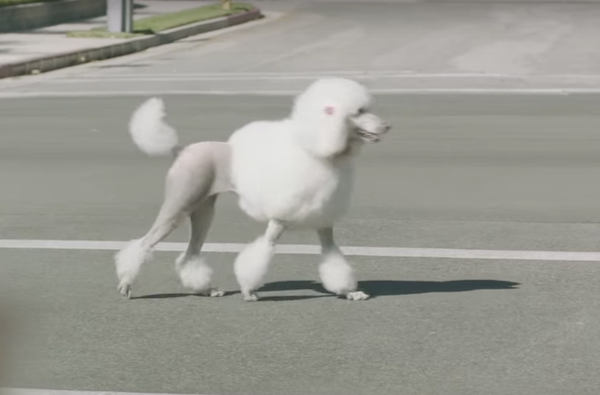
We’re using Subaru’s otherwise wonderful commercial seen below (what would it have hurt if both “mom” and “dad” were the same breed?) to segue into a brief discussion of a particular dog gait.
How many of you noticed that the Poodle crossing the street in the commercial was pacing?
Pacing occurs when both legs on the same side of the dog (the right front and the right rear, for example) reach forward at the same time. Technically speaking, it’s a “two-beat lateral gait,” and some refer to the movement as “side-wheeling” because the legs on each side move as a pair.
Pacing can be a tricky subject because it’s not always a bad thing. Puppies, especially large breed pups, can pace to cope with uneven growth, a way of compensating during a gangly stretch. In adults, pacing is often used as a transition gait (though its frowned upon in a show ring). It’s characteristic of a few large breeds, and at least one breed’s standard mentions it: (From the Old English Sheepdog standard: “May amble or pace at slower speeds.” Judges can ask a handler to move their OES at a walk to see that the dog’s body doesn’t bow during the pace). Many maintain that herding dogs of all kinds tend to pace.
The pace is economical in terms of energy use which is why we might notice our dog pace after a long walk; it allows for reasonable speed for a long distance.
A dog pacing all the time, however, is inefficient because the dog’s center of gravity continuously shift from side to side, and the dog has to expend energy to re-center its weight. This is a waste of energy and keeps a dog from responding quickly if she needs break into a run. A pacing dog loses out on accessing a variety of speeds because they first have to slow down to an amble, or speed up to a trot. McDowell Lyon wrote in, “The Dog in Action,” “….one underlying factor…brings out this gait [pace] at such times; it is the animal’s reluctance to fight lateral displacement, an ever present force in all gaits which is recognized by horsemen but by few dog breeders.”
Pacing occurs in dogs that have more angulation in the rear than in the front; the rear feet can hit the front legs when trotting, so the dog paces to avoid clipping its front feet.
Pacing can also be a sign of a dog that’s out of shape, but it can also suggest discomfort or even pain in the muscles through the middle of the dog’s back. When a dog is trotting, there’s a lot of rotational movement through this area, and if the muscles are sore, the dog will pace to avoid that rotational movement. Many canine chiropractors look at a dog’s sudden preference to pace as a warning sign.
It’s a scourge to the handler with a pacing show dog. Trainers sometimes say that a handler can “break” pacing by either speeding up their own gait, or with a discreet “snap” of the leash clueing the dog that it’s time to move out, but it’s not always as easy as that.
First, learn to spot pacing. Sometimes, just watching your dog’s back as you gait can provide a clue that your dog is doing it since a pace produces a flat rocking movement. If your dog does pace, pay attention to when s/he does it. There’s a big difference between a dog who has always paced, one who paces at the end of an energetic exercise, and one who just begun pacing out of the blue.

For square built breeds, pacing is one of two equaly valid options to prevent the hind legs from kicking the front legs.
Though Kerries are not considered a “Herding” breed, they are used for herding, past, present & future. So, should it not be acceptable for a Kerry to pace at an ambling/herding speed?
PLEASE do not promote the idea of “a discreet “snap” of the leash.” This does not “cue” the dog to anything except discomfort. The handler can adjust their speed, adjust their length of stride or just simply stop and start over. It is also effective to face the dog in the opposite direction to which it will be going and then take off (without popping or snapping the lead).
I don’t feel a sharp snap would be good for the dog or trust of handle. Either go faster or stop for a step and start again to break the pattern. It’s pikes on the ground to make your dog trot over, like 10 sweeping brush handles trot over then, place far enough apart for the dog to reach but not jump to cover the ground, so they need to look to see what they are doing